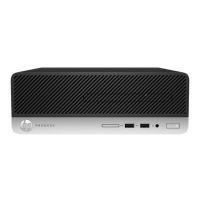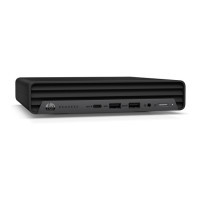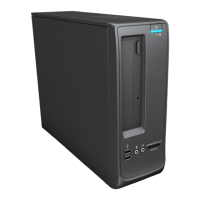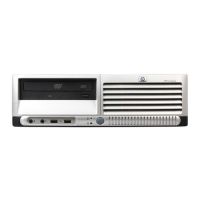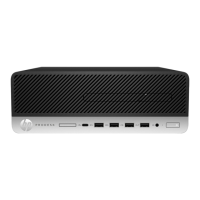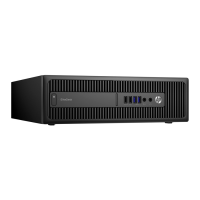The memory sockets on the system board are populated with at least one preinstalled memory module.
To achieve the maximum memory support, you can populate the system board with up to 128 GB of
memory configured in a high-performing dual-channel mode.
The computer supports the following setups:
● 512 Mbit, 1 Gbit, 2 Gbit, and 4 Gbit non-ECC memory technologies
● Single-sided and double-sided memory modules
● Memory modules constructed with ×8 and ×16 DDR devices; memory modules constructed with ×4
SDRAM are not supported
NOTE: The system does not operate properly if you install unsupported memory modules.
Four memory sockets are located on the system board, with two sockets per channel. The sockets are
labeled DIMM1, DIMM2, DIMM3, and DIMM4. Sockets DIMM1 and DIMM2 operate in memory channel B.
Sockets DIMM3 and DIMM4 operate in memory channel A.
The system automatically operates in single-channel mode, dual-channel mode, or flex mode, depending
on how the DIMMs are installed.
NOTE: Single-channel and unbalanced dual-channel memory configurations result in inferior
graphics performance.
● The system operates in single-channel mode if the DIMM sockets are populated in one channel only.
● The system operates in a higher-performing dual-channel mode if the total memory capacity of
the DIMMs in channel A is equal to the total memory capacity of the DIMMs in channel B. The
technology and device width can vary between the channels. For example, if channel A is populated
with two 1 GB DIMMs and channel B is populated with one 2 GB DIMM, the system operates in
dual-channel mode.
● The system operates in flex mode if the total memory capacity of the DIMMs in channel A is not
equal to the total memory capacity of the DIMMs in channel B. In flex mode, the channel populated
with the least amount of memory describes the total amount of memory assigned to dual channel,
and the remainder is assigned to single channel. For optimal speed, balance the channels so that
the largest amount of memory is spread between the two channels. If one channel has more
memory than the other, assign the larger amount to channel A. For example, if you are populating the
sockets with one 2 GB DIMM and three 1 GB DIMMs, populate channel A with the 2 GB DIMM and one
1 GB DIMM, and populate channel B channel with the other two 1 GB DIMMs. With this configuration,
4 GB runs as dual channel and 1 GB runs as single channel.
● In any mode, the maximum operational speed is determined by the slowest DIMM in the system.
IMPORTANT: You must disconnect the power cord and wait approximately 30 seconds for the power
to drain before adding or removing memory modules. Regardless of the power state, voltage is always
supplied to the memory modules as long as the computer is plugged into an active AC outlet. Adding or
removing memory modules while voltage is present can cause irreparable damage to the memory
modules or system board.
The memory module sockets have gold-plated metal contacts. When upgrading the memory, it is
important to use memory modules with gold-plated metal contacts to prevent corrosion, oxidation, or
both resulting from having incompatible metals in contact with each other.
Memory modules (DIMMs)
35

